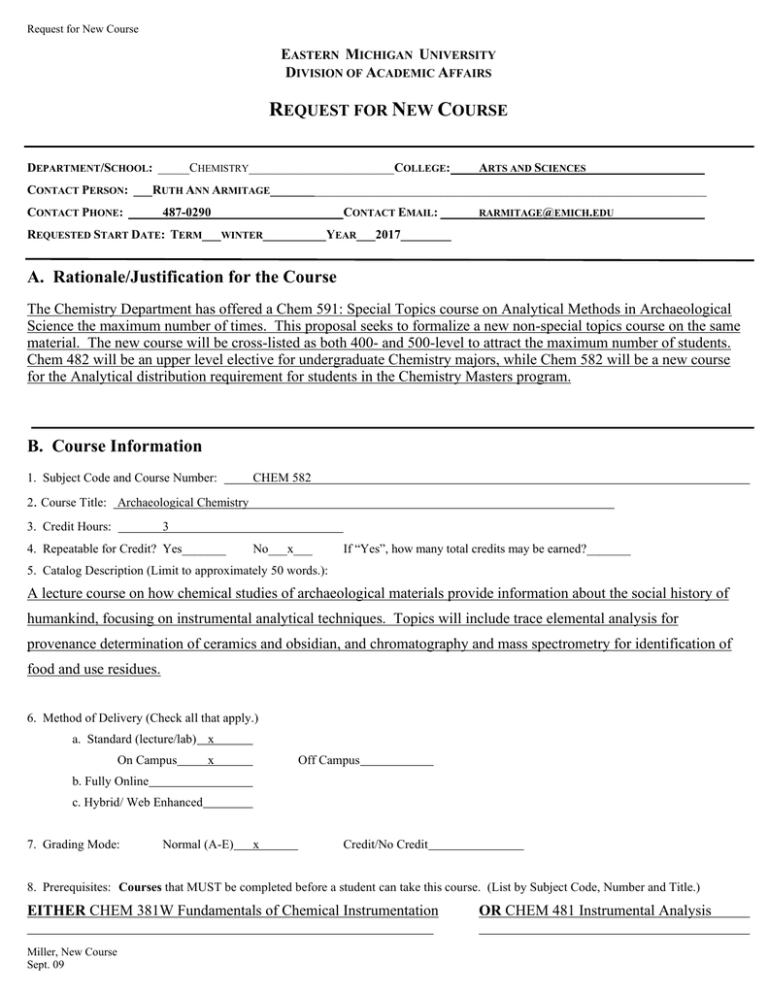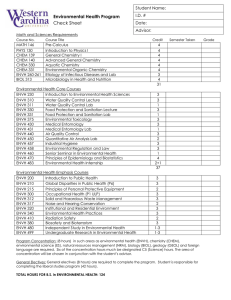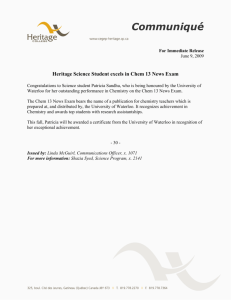R N C
advertisement

Request for New Course EASTERN MICHIGAN UNIVERSITY DIVISION OF ACADEMIC AFFAIRS REQUEST FOR NEW COURSE DEPARTMENT/SCHOOL: _____CHEMISTRY_______________________COLLEGE: ARTS AND SCIENCES CONTACT PERSON: ___RUTH ANN ARMITAGE_____________________________________________________________________ CONTACT PHONE: 487-0290 CONTACT EMAIL: RARMITAGE@EMICH.EDU REQUESTED START DATE: TERM___WINTER__________YEAR___2017________ A. Rationale/Justification for the Course The Chemistry Department has offered a Chem 591: Special Topics course on Analytical Methods in Archaeological Science the maximum number of times. This proposal seeks to formalize a new non-special topics course on the same material. The new course will be cross-listed as both 400- and 500-level to attract the maximum number of students. Chem 482 will be an upper level elective for undergraduate Chemistry majors, while Chem 582 will be a new course for the Analytical distribution requirement for students in the Chemistry Masters program. B. Course Information 1. Subject Code and Course Number: CHEM 582 2. Course Title: Archaeological Chemistry 3. Credit Hours: 3 4. Repeatable for Credit? Yes_______ No___x___ If “Yes”, how many total credits may be earned?_______ 5. Catalog Description (Limit to approximately 50 words.): A lecture course on how chemical studies of archaeological materials provide information about the social history of humankind, focusing on instrumental analytical techniques. Topics will include trace elemental analysis for provenance determination of ceramics and obsidian, and chromatography and mass spectrometry for identification of food and use residues. 6. Method of Delivery (Check all that apply.) a. Standard (lecture/lab) x On Campus x Off Campus b. Fully Online c. Hybrid/ Web Enhanced 7. Grading Mode: Normal (A-E) x Credit/No Credit 8. Prerequisites: Courses that MUST be completed before a student can take this course. (List by Subject Code, Number and Title.) EITHER CHEM 381W Fundamentals of Chemical Instrumentation Miller, New Course Sept. 09 OR CHEM 481 Instrumental Analysis New Course Form 9. Concurrent Prerequisites: Code, Number and Title.) Courses listed in #5 that MAY also be taken at the same time as a student is taking this course. (List by Subject n/a 10. Corequisites: Courses that MUST be taken at the same time as a student in taking this course. (List by Subject Code, Number and Title.) n/a 11. Equivalent Courses. A student may not earn credit for both a course and its equivalent. A course will count as a repeat if an equivalent course has already been taken. (List by Subject Code, Number and Title) n/a 12. Course Restrictions: a. Restriction by College. Is admission to a specific College Required? College of Business Yes No x College of Education Yes No x b. Restriction by Major/Program. Will only students in certain majors/programs be allowed to take this course? Yes No x If “Yes”, list the majors/programs c. Restriction by Class Level Check all those who will be allowed to take the course: Undergraduate Graduate All undergraduates_______ All graduate students__x__ Freshperson Certificate Sophomore Masters Junior Specialist Senior X Doctoral Second Bachelor_ X______ UG Degree Pending_____ Post-Bac. Tchr. Cert._____ Low GPA Admit_______ Note: If this is a 400-level course to be offered for graduate credit, attach Approval Form for 400-level Course for Graduate Credit. Only “Approved for Graduate Credit” undergraduate courses may be included on graduate programs of study. Note: Only 500-level graduate courses can be taken by undergraduate students. Undergraduate students may not register for 600-level courses d. Restriction by Permission. Will Departmental Permission be required? Yes No (Note: Department permission requires the department to enter authorization for every student registering.) 13. Will the course be offered as part of the General Education Program? Yes No Miller, New Course Sept. ‘09 x x Page 2 of 8 New Course Form If “Yes”, attach Request for Inclusion of a Course in the General Education Program: Education for Participation in the Global Community form. Note: All new courses proposed for inclusion in this program will be reviewed by the General Education Advisory Committee. If this course is NOT approved for inclusion in the General Education program, will it still be offered? Yes No C. Relationship to Existing Courses Within the Department: 14. Will this course will be a requirement or restricted elective in any existing program(s)? Yes x No If “Yes”, list the programs and attach a copy of the programs that clearly shows the place the new course will have in the curriculum. Program MASTER OF SCIENCE IN CHEMISTRY Program 15. Will this course replace an existing course? Yes No Required Restricted Elective x Required Restricted Elective x 16. (Complete only if the answer to #15 is “Yes.”) a. Subject Code, Number and Title of course to be replaced: b. Will the course to be replaced be deleted? Yes No 17. (Complete only if the answer #16b is “Yes.”) If the replaced course is to be deleted, it is not necessary to submit a Request for Graduate and Undergraduate Course Deletion. a. When is the last time it will be offered? Term Year b. Is the course to be deleted required by programs in other departments? Contact the Course and Program Development Office if necessary. Yes No c. If “Yes”, do the affected departments support this change? Yes No If “Yes”, attach letters of support. If “No”, attach letters from the affected department explaining the lack of support, if available . Outside the Department: The following information must be provided. Contact the Course and Program Development office for assistance if necessary. 18. Are there similar courses offered in other University Departments? If “Yes”, list courses by Subject Code, Number and Title Yes No x 19. If similar courses exist, do the departments in which they are offered support the proposed course? Yes No If “Yes”, attach letters of support from the affected departments. If “No”, attach letters from the affected department explaining the lack of support, if available. Miller, New Course Sept. ‘09 Page 3 of 8 New Course Form D. Course Requirements 20. Attach a detailed Sample Course Syllabus including: a. b. c. d. e. f. g. h. Course goals, objectives and/or student learning outcomes Outline of the content to be covered Student assignments including presentations, research papers, exams, etc. Method of evaluation Grading scale (if a graduate course, include graduate grading scale) Special requirements Bibliography, supplemental reading list Other pertinent information. NOTE: COURSES BEING PROPOSED FOR INCLUSION IN THE EDUCATION FOR PARTICIPATION IN THE GLOBAL COMMUNITY PROGRAM MUST USE THE SYLLABUS TEMPLATE PROVIDED BY THE GENERAL EDUCATION ADVISORY COMMITTEE. THE TEMPLATE IS ATTACHED TO THE REQUEST FOR INCLUSION OF A COURSE IN THE GENERAL EDUCATION PROGRAM: EDUCATION FOR PARTICIPATION IN THE GLOBAL COMMUNITY FORM. E. Cost Analysis (Complete only if the course will require additional University resources. Fill in Estimated Resources for the sponsoring department(s). Attach separate estimates for other affected departments.) Estimated Resources: Year One Year Two Year Three Faculty / Staff $_________ $_________ $_________ SS&M $_________ $_________ $_________ Equipment $_________ $_________ $_________ Total $_________ $_________ $_________ F. Action of the Department/School and College 1. Department/School Vote of faculty: For ___21_____ Against ___0_____ Abstentions ____0_____ (Enter the number of votes cast in each category.) Ross Nord Department Head/School Director Signature March 18, 2016 Date 2. College/Graduate School A. College College Dean Signature Date B. Graduate School (if Graduate Course) Graduate Dean Signature Date G. Approval Associate Vice-President for Academic Programming Signature Miller, New Course Sept. ‘09 Date Page 4 of 8 New Course Form Master of Science in Chemistry (including CHEM 582) Degree Requirements Students in this program follow either the Thesis Plan or the Non-Thesis Plan. All students must take one-credit hour courses in information retrieval, safety, and scientific writing in addition to distribution requirements of three graduate chemistry courses in various disciplines. Required Courses: 2 hours CHEM 610 - Information Retrieval in Chemistry 1 hr CHEM 620 – Chemical Safety 1 hr Distribution Requirement Courses: 6 – 9 hours Courses from at least three areas of chemistry must be taken. I. Analytical CHEM 581 – Advanced Analytical Chemistry 3 hrs CHEM 582 – Archaeological Chemistry 3 hrs CHEM 591 – Special Topics in Analytical Chemistry 2 hrs II. Inorganic/Environmental CHEM 632 – Structural Inorganic Chemistry 3 hrs III. Organic CHEM 571 – Advanced Organic Chemistry 3 hrs IV. Physical CHEM 561 – Quantum Chemistry and Spectroscopy 2 hrs CHEM 562 – Statistical Mechanics and Chemical Kinetics 2 hrs V. Biochemistry: CHEM 555 – Neurochemistry 3 hrs CHEM 556 – Cell Signaling and Disease 3 hrs CHEM 558 – Chemical Biology 3 hrs CHEM 557 -- Medicinal Chemistry and Drug Design 3 hrs VI. Polymer CHEM 665 – Physical Chemistry of Polymers 2 hrs CHEM 675 – Advanced Organic Polymer Chemistry 3 hrs Thesis Plan This plan requires satisfactory completion of a minimum of 30 hours of graduate credit. Students will be accepted into the thesis plan after two semesters of enrollment and at least one credit taken under an advisor. The student will be approved to continue with the thesis plan based upon the recommendation of their graduate advisor and approval of the graduate committee. Three additional required courses for this thesis plan are CHEM 530 – Scientific Writing 1 hr CHEM 690 -- Directed Readings 1 hr CHEM 691 – Seminar in Chemistry 1 hr Miller, New Course Sept. ‘09 Page 5 of 8 New Course Form Thesis plan students must submit a written thesis based on original research along with an oral presentation of the research to the Department of Chemistry. A maximum of 10 hours of CHEM 697/698/699 – Research in Chemistry may be used toward the degree in the thesis plan. For research credits to be awarded, a written report of research must be submitted to and approved by the research advisor Non-Thesis Plan This plan requires satisfactory completion of a minimum of 30 hours of graduate credits. Students must complete a total of six to ten hours of graduate based laboratory courses CHEM 413, 433, 453, 463 and/or of CHEM 697/698/699 – Research in Chemistry. A maximum of six research credits can be completed under the non-thesis plan. For research credits to be awarded, a written report of research must be submitted to the research advisor and approved by the research mentor. *Elective Courses Courses selected from among graduate courses at the 500- or 600-level, or from approved 400-level CHEM courses. Courses are selected in consultation with the graduate coordinator and student’s thesis research director. Courses that are offered include those in the distribution requirements along with those below: CHEM 515 – Industrial and Environmental Chemistry 2 hrs CHEM 565 – Nuclear Chemistry 2 hrs CHEM 572 – Advanced Organic Spectrophotometric Determination 2 hrs CHEM 581 – Special Topics 2 hrs CHEM 610 – Computer Applications in Chemistry The following laboratory courses may be taken with the approval of the Graduate Coordinator: CHEM 533 – Inorganic-Organic Synthesis Laboratory, 2 hrs CHEM 553 – Biochemistry Laboratory, 2 hrs CHEM 563 – Physical Chemistry Laboratory, 2 hrs CHEM 530 – Scientific Writing, 1 hr (for non-thesis students) Students interested in teaching may take the following elective courses with the approval of the Graduate Coordinator: Education Teaching/Research CHEM 520 – Advanced Methodology for Secondary Chemistry Teachers CHEM 525 – Modern Chemistry for Educators I CHEM 526 – Modern Chemistry for Educators II *Laboratory Courses Courses offered to students who wish to advance their knowledge through laboratory courses. Students who have taken undergraduate courses of CHEM 433, CHEM 453, and CHEM 463 are not eligible to take these courses for credit towards their program of study. CHEM 533 – Inorganic/Organic Synthesis Laboratory CHEM 553 – Biochemistry Laboratory CHEM 564 - Physical-Chemical Characterization of Materials Research Credits An approved written thesis and an oral presentation of the research to the Department of Chemistry is required with six to ten hours of research credit. CHEM 697 - Research in Chemistry 1 hr CHEM 698 - Research in Chemistry 2 hrs CHEM 699 - Research in Chemistry 3 hrs Cognate Courses: 0-6 hours Zero to six hours selected from courses outside the Department of Chemistry with the approval of the graduate coordinator. Note students interested in educational research may take the following cognate courses with the approval of the graduate coordinator. EDPS 621 – Statistical Applications in Educational Research EDPS 667 – Principles of Educational Research EDPS 674 – Survey Research and Data Analysis EDPS 677 – Methods in Quantitative Research EDPS 678 – Qualitative/Interpretive Research Miller, New Course Sept. ‘09 Page 6 of 8 New Course Form CHEM 582 Archaeological Chemistry Winter 2017 Dr. Ruth Ann Armitage Prerequisite: An instrumental analysis course (either CHEM 381 or CHEM 481) Office: 501J Science Complex Office hours: Tues, Wed, and Thurs 2-3 pm or by appointment Phone: 487-0290 Email: rarmitage@emich.edu Textbook: Archaeological Chemistry by Pollard, Heron and Armitage. 3rd edition. Available online at http://pubs.rsc.org/en/content/ebook/9781782624264. (Cost is $70.99 when purchased directly from RSC.) Class time: 5:30-6:45 pm TR Classroom: Science 545 Course website: EMU Canvas site (TBD) This course will demonstrate how chemistry is used in archaeological and geosciences to study human behavior on the elemental and molecular level. The goal of the course is to familiarize students with the techniques, limitations, and capabilities of applying analytical chemistry to artifacts and human remains. Emphasis will be placed on the problem solving aspects of these analytical approaches, as archaeological samples tend to be limited in size and highly susceptible to contamination and diagenetic change. Applications of instrumentation to complex problems in the analysis of archaeological materials will be emphasized. Grading Major paper Topic essay Rough draft of major paper 2 review papers Participation 4 in-class presentations Annotated bibliography Total: 100 points 10 points 25 points 25 points each 20 points 20 points each 10 points each (3 versions) 325 points Major paper: This will be a review paper on an archaeological chemistry topic of your choice. This can be approached either by choosing an analytical technique (e.g., NMR spectroscopy) and reviewing the applications of this method to archaeological materials (e.g., characterization of jet, resins and amber, etc.), or by choosing a material (e.g., textile dyes) and reviewing the methods that have been used to study that material (e.g., LC-DAD-MS, DART-MS, SERS). This paper will be completed in several steps. First, a one-page essay describing the topic you will be researching will be turned in on Jan 24. This essay, worth 20 points, will justify your reason for choosing the topic. Some suggestions will be provided, but you will need to determine if there is sufficient material in the literature to write a review paper. An annotated bibliography will be kept throughout your progress on your paper; the first version of this bibliography, worth 10 points, will be due on Feb 2. A description of an annotated bibliography will be provided. Updated versions of the bibliography will be collected on March 16 and April 11; these will also be worth 10 points each. A rough draft of your final paper (25 points) is due on March 23. This should take the form of a detailed outline, but does not need to be an actual draft, though you will get better feedback on a completed draft. The final paper, due on the day of the final exam (Tuesday, April 25) will be worth 100 points. Guidelines for writing this paper, as well as a grading rubric, will be provided. Review papers: These are short, 2-3 page papers critically reviewing specific articles that will be provided. These should be considered “exams” as you must work independently on the reviews and rely on your knowledge of the material to evaluate the papers. Further guidelines will be provided. Each of the two papers will be worth 25 points. These papers are due Mar 2 and Apr 4. Participation: 20 points. These points will be tabulated throughout the semester for participating in discussions and attending class. Presentations: You will be giving four presentations during the semester, worth 20 points each. The first presentations will be during class on Jan 26. You and a partner will be assigned a recent paper on ceramics or glass for the first discussion. Your group will have ~15 minutes to present the paper to the class. Future presentations will cover other topics. Papers will be preselected for the class, but each group will have to choose a specific paper from that selection. Differences between CHEM 482 and CHEM 582: Miller, New Course Sept. ‘09 Page 7 of 8 New Course Form 1. Graduate students will be expected to use the knowledge they gained in CHEM 610 to search the primary literature for papers to include in their review papers. Graduate papers should have a more comprehensive review of the primary source literature. 2. Graduate students will facilitate and lead the discussions of the case studies at the end of the semester. As graduate students, your chemistry knowledge and backgrounds should be stronger than those of the undergraduate students. You will therefore be expected to take leadership roles in discussions. 3. Graduate students will be held to a higher standard of performance (see grade distribution below). The rules, etc: What I hope to accomplish in the class will only happen if we all put in the required effort. This includes attendance – on time – to all lectures. I will not take attendance, but I expect you to be in class because your participation is required. Only those who have read the assigned materials before coming to class may participate in discussions; failure to read the assignments will negatively affect your participation grade. YOU are responsible for everything that occurs during class time. You must have a documented excuse for making up any in-class assignments. Excused absences include illness (requires a doctor’s note), court appearance, religious holiday that EMU does not observe, death in your family, etc. All excused absences require documentation and, where possible, prior approval (i.e. court appearances and religious holidays). While working in a group is a vital part of becoming a good scientist, take credit only for what you have done. University and departmental policies on cheating, which includes plagiarism, will be enforced in all assignments. Policies are attached to this syllabus. Grade distribution for Chem 582: A 96-100% B+ 90-92% A92-95% B 87-89% B83-86% C+ C C- 80-82% 77-79% 73-76% F <73% Note: These values will never be increased, though the minimum values may be lowered at my discretion. Tentative schedule: Date Jan 5 Topic Syllabus/academic honesty, Intro to Arch Chem. Jan 10 Jan 12 Review: OES, AAS, ICP-AES, ICP-MS; isotopes Intro to X-ray methods and Auger electron spectroscopy Geochemistry of Clays and Provenance of Ceramics Chemistry and Corrosion of Archaeological Glass Selection of papers/discussion on ceramics/glass Presentations on ceramics and glass Review: GC, GC-MS, isotope and small molecule MS Isotopic fractionation and paleodietary studies Lipid Residues and Milk Selection of papers/discussion on isotopes/residues Presentations on isotopes/residues Flex day- catch up Winter Break Winter Break Protein residues in archaeology Protein mass spectrometry: ESI, MALDI, LC-MS/MS Archaeological proteomics Selection of papers/discussion on proteins Presentations on proteins Dating methods: radiocarbon, amino acid racemization, luminescence dating (TL and OSL) Dating methods cont’d Selection of papers/discussion on dating methods Presentations on dating methods In class peer review of rough drafts Raman and IR spectroscopy Resins and dyes Case study: radiocarbon and binding media in rock art Case study: dyes in textiles by DART-MS, LC-DADMS and SERS Case study: peptide mass fingerprinting in heritage science Case study: TBD Case study: TBD Final paper due by 6:45 pm by email. Jan 17 Jan 19 Jan 24 Jan 26 Jan 31 Feb 2 Feb 7 Feb 9 Feb 14 Feb 16 Feb 21 Feb 23 Feb 28 Mar 2 Mar 7 Mar 9 Mar 14 Mar 16 Mar 21 Mar 23 Mar 28 Mar 30 Apr 4 Apr 6 Apr 11 Apr 13 Apr 15 Apr 20 Apr 22 Apr 25 Miller, New Course Sept. ‘09 Reading Syllabus and Chapter 1 Additional readings on Canvas Chapter 2 Chapter 2, additional readings on Canvas Chapter 4 Chapter 5 Papers on Canvas Chapter 2 Chapter 10 Chapter 11 Papers on Canvas Materials due Topic essay Presentation 1 Bibliography v.1 Presentation 2 Chapter 12 Chapters 2 and 12 Chapter 12, part of 11 Papers on Canvas Chapter 9 plus additional readings from Canvas Papers on Canvas Review #1 Presentation 3 Bibliography v. 2 Rough draft Presentation 4 Chapter 2 plus additional readings Chapter 7 plus additional readings Papers on Canvas Review #2 Papers on Canvas Bibliography final Papers on Canvas Papers on Canvas Papers on Canvas Final paper Page 8 of 8




